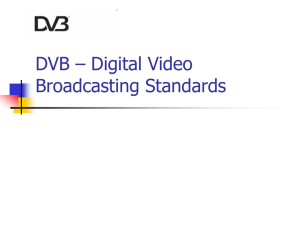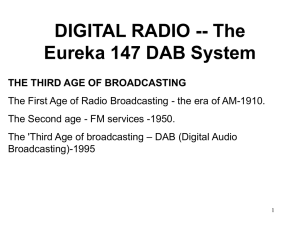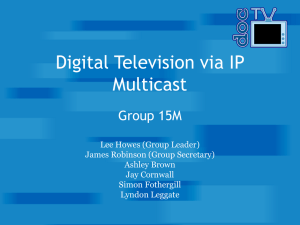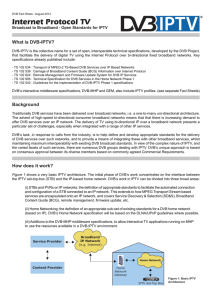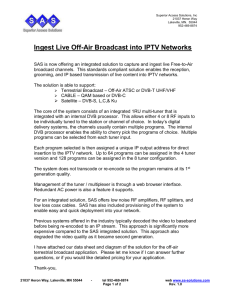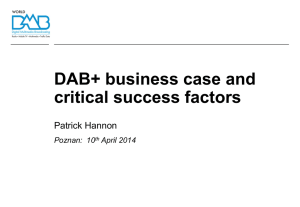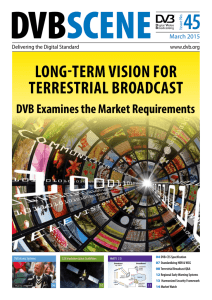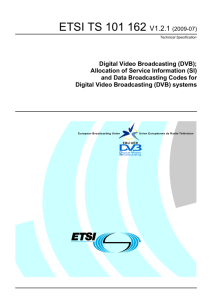5 Broadcast of IP over DVB
advertisement
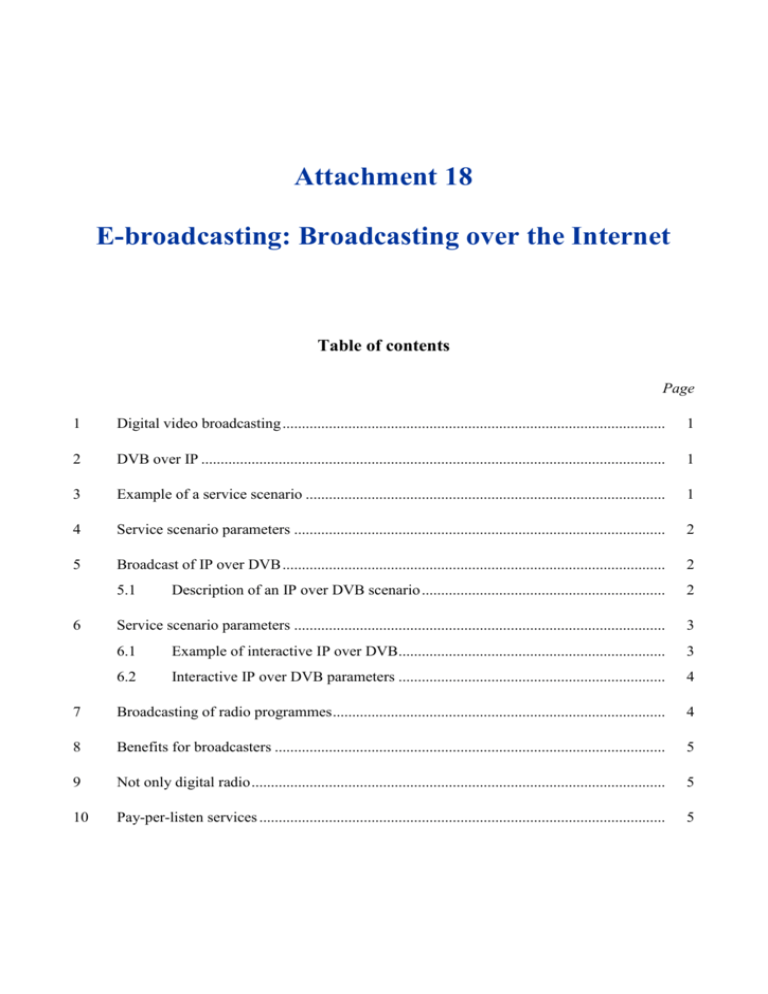
Attachment 18 E-broadcasting: Broadcasting over the Internet Table of contents Page 1 Digital video broadcasting ................................................................................................... 1 2 DVB over IP ........................................................................................................................ 1 3 Example of a service scenario ............................................................................................. 1 4 Service scenario parameters ................................................................................................ 2 5 Broadcast of IP over DVB ................................................................................................... 2 5.1 Description of an IP over DVB scenario ............................................................... 2 Service scenario parameters ................................................................................................ 3 6.1 Example of interactive IP over DVB..................................................................... 3 6.2 Interactive IP over DVB parameters ..................................................................... 4 7 Broadcasting of radio programmes ...................................................................................... 4 8 Benefits for broadcasters ..................................................................................................... 5 9 Not only digital radio ........................................................................................................... 5 10 Pay-per-listen services ......................................................................................................... 5 6 Internet Protocol (IP) – Attachments E-broadcasting: Broadcasting over the Internet 1 Digital video broadcasting The broadcasting of digital multimedia content was boasted by the birth of two main technologies: the digital video encoding standard known as MPEG-2 and the definition of the transmission protocol known as digital video broadcasting (DVB). DVB was originally born to replace the old analogue television, but it is now earning consensus for Internet-based broadcast (a.k.a. DVB over IP). DVB is a transmission scheme based on the MPEG-2 video compression/transmission protocol and utilizing the standard MPEG-2 transmission scheme. It is however much more than a simple replacement for existing analogue television transmission. In the first case, DVB provides superior picture quality with the opportunity to view pictures in standard format or wide screen (16:9) format, along with mono, stereo or surround sound. It also allows a range of new features and services including subtitling, multiple audio tracks, interactive content, multimedia content – where, for instance, programmes may be linked to worldwide web material. DVB is a European initiative. Equipment conforming to the DVB standard is now in use on six continents and DVB is rapidly becoming the worldwide standard for digital TV. At the time DVB was being developed in Europe, a parallel programme of standards and equipment development was also being implemented in the United States by the Advanced Television Systems Committee (ATSC). Among other things ATSC adopts a different audio coding standard, and vestigial sideband (VSB) modulation. The United States has adopted a system based on ATSC, called digital TV (DTV). During standardization this evolved into a hot debate between the PC-based manufacturers (favouring a non-interlaced display) and the TV manufacturers (favouring an interlaced format). There is much in common between the United States and European standards and inter-operation between some DVB and DTV equipment has been demonstrated. 2 DVB over IP DVB over IP is the expression used to describe delivery of digital television services (DVB) to homes over broadband IP networks. Typically this will be over cable so that the supplier can achieve the "triple play" bundling of voice (over-IP) telephone as well as Internet with the television service. This has great potential for interactive television as it includes a built-in fast return link to the service provider. 3 Example of a service scenario A DVB-T/S broadcaster provides a service of high quality digital video delivery (MPEG-2 video). The well-known end-user terminals used in these scenarios are the set-top boxes. The example depicted in Figure 1 shows how an IP network can provide the same services to the IP terminals it manages. The MPEG-2 transport stream is received and fed to an IP encapsulator. The encapsulator can process all or part of the MPEG-2 stream and encapsulate the MPEG-2 packets into IP datagrams. These datagrams are conveyed on a LAN to the end users that can directly retrieve and decode the MPEG-2 programme. Attachment 18 – E-broadcasting: Broadcasting over the Internet 1 Internet Protocol (IP) – Attachments Figure 1 – DVB over IP 4 Service scenario parameters Table 1 –Service scenario parameters for DVB over IP Service type Content type Content format Network/play out channel Audio video MPEG-2 DVB (T, S…) Unidirectional broadcast of IP data MPEG-2 over IP + LAN Streaming of IP data 5 Distribution/ End-user usage mode terminal/device Push PC on LAN Set top boxes Broadcast of IP over DVB This expression normally designates the delivery of IP data and services over DVB networks. Also referred to as datacasting, this takes advantage of the very wideband data delivery systems designed for the broadcast of digital television, to deliver IP-based data services – such as file transfers, multimedia, Internet and carousels, which may complement, or be instead of, TV. As a result of DVB-Terrestrial's ability to provide reliable reception to mobile as well as fixed receivers, there are possibilities to send IP-style service to people on the move. For interactivity, a return path can be established by telephone. 5.1 Description of an IP over DVB scenario In this scenario, content is streamed to an IP network in multicast. End users connected to the network can retrieve the services and visualize the content. A gateway allows a DVB hop to be effected by encapsulating the IP datagrams to MPEG-2 Transport Stream (TS) packets. On the reception side, a gateway retrieves the IP datagrams from the MPEG-2 packets and feeds them to another IP network. The streamed content is thus also available on the second IP domain. 2 Attachment 18 – E-broadcasting: Broadcasting over the Internet Internet Protocol (IP) – Attachments Content streamed could be any format accepted by IP. It can be MPEG-2 over IP, MPEG-4 over IP or others. deencapsulation Figure 2 – Broadcast of IP over DVB 6 Service scenario parameters Table 2 – Service scenario parameters for broadcast of IP over DVB Service type Content type Unidirectional Audio broadcast of IP data video Content format Network/play Distribution/ End-user out channel usage mode terminal/device MPEG-2 over IP DVB (T, S…) Push MPEG-4 over IP + LAN PC on LAN Streaming of IP data 6.1 Example of interactive IP over DVB Multicast services implementation in a hybrid network may call for IP multicast protocols to be supported. One way but not the only way, to allow multicast services is to use the unidirectional link routing protocol (UDLR) which provides a mechanism that emulates bidirectional connectivity between the interfaces of a one-way channel through IP bidirectional return channel. A DVB link is used to provide the incoming stream to an Internet client. The Internet client performs a request on an outgoing low bit rate request. The remote server receives the request and the response is routed to an IP to DVB encapsulator and then sent on the DVB link. On the receiving side, a router redirects the requested answer to the terminal. Several protocols exist to encapsulate IP into DVB (data piping, data streaming, MPE, ULE…). Attachment 18 – E-broadcasting: Broadcasting over the Internet 3 Internet Protocol (IP) – Attachments Figure 3 – UDLR usage for interactive broadcast of IP over DVB 6.2 Interactive IP over DVB parameters Table 3 – Service scenario parameters for interactive IP over DVB Service type Content type Unidirectional Audio broadcast of IP data video Content format Network/play Distribution/ End-user out channel usage mode terminal/device IP over MPEG-2 TS DVB (T, S…) Push Bidirectional MPEG-2 over IP + LAN Interactive MPEG-4 over IP PC on LAN HTML MP2 audio Jpg, gif 7 Broadcasting of radio programmes Digital audio broadcasting (DAB) technology provides a high capacity data broadcast network to mobile and fixed users. Broadcasters are now transmitting their existing services in high quality MPEG layer 2 format and new services are being offered exclusively to DAB listeners. Broadcast data services are also appearing in the form of broadcast websites, and other applications. DAB is a digital radio system, which was developed by the Eureka 147 Project. It offers near CD-quality sound, more stations, additional radio and data services and therefore wider choice of programmes, ease of tuning and interference-free reception for the listener, plus the information potential of data, graphics and text. For the broadcaster, DAB provides a means of reaching listeners with sound quality on an equal footing with the CD player, and the ability to offer extra, potentially revenue-creating services. Transmission will also be cheaper. For other areas of industry, there will be a new market for receivers and transmission equipment. 4 Attachment 18 – E-broadcasting: Broadcasting over the Internet Internet Protocol (IP) – Attachments 8 Benefits for broadcasters Broadcasters will accrue many benefits from DAB. Audiences will be able to enjoy better reception and find individual stations more easily–that means less complaints are likely to be received about these two topics! The near CD-quality sound that DAB offers means that radio will once again be able to directly compete against the perfect audio quality that the domestic CD or the very high quality cassette can reproduce. Unless broadcasters exploit this, they will lose listeners, particularly the younger generation, to these personal high-quality entertainment sources. Broadcasters will be able to offer more services, since DAB is flexible. Each package of radio stations (known as an ensemble) can be reconfigured at any time to allow new services to start and others to end. Extra sports commentaries can be added when matches start, or live classical music concerts can have extra digital capacity allocated to ensure that audiophiles receive the ultimate sound quality. Transmission will be cheaper too. DAB can be transmitted at lower power than today's FM and AM signals yet with no loss in geographic coverage, which means less cost to the broadcaster (and less power consumption means DAB is more environmentally friendly than conventional FM and AM). Another advantage of digital radio transmission is that it is a cost-effective and powerful advertising medium. 9 Not only digital radio DAB was developed with the aim of improving radio reception. This is why audio transmission was at the forefront of the development process. But DAB, as a digital transmission system, can transmit other data as well as audio. In principle any type of information can be transmitted by DAB, provided simply that it is available in digital form and does not exceed the maximum available DAB data rate (approx. 1.7 Mbit/s). Examples of such additional services are still pictures accompanying radio programmes, digitized traffic messages (Traffic Message Channel), electronic newspapers, software updates and even animated video. This process leads to 'multimedia broadcasting' in which all forms of information can be conveyed via the common transmission medium DAB. In this context DAB could be described as the 'cordless information highway'. In contrast to multimedia applications via TV/cable, DAB additional services can also be received in a car and with portable equipment. 10 Pay-per-listen services Because DAB receivers are intelligent, they can be configured to include pay radio services. Some broadcasters might offer special concerts available only on payment (because DAB is flexible, new services like pay channels – or extra conventional free-to-air channels – can be added without having to switch off the ones already on the air), which you would subscribe to on an individual or long-term basis. Specialist financial services might also be available on subscription via DAB. And then there are the futuristic possibilities which DAB might make a reality, like personal receivers that could correlate and compare the signals from global positioning system satellites in order to pinpoint your exact location. Because DAB is computer-based, it might also one day transmit and receiver computer files (like the Internet and e-mail) or fax transmissions. DAB's possibilities are endless. Attachment 18 – E-broadcasting: Broadcasting over the Internet 5
